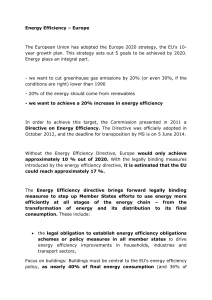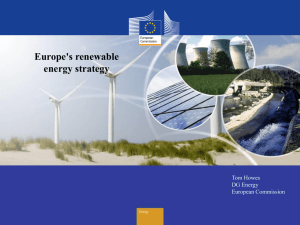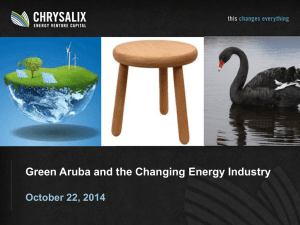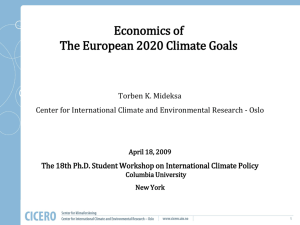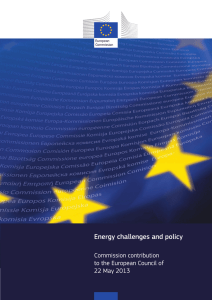Alan Lovell presentation
advertisement
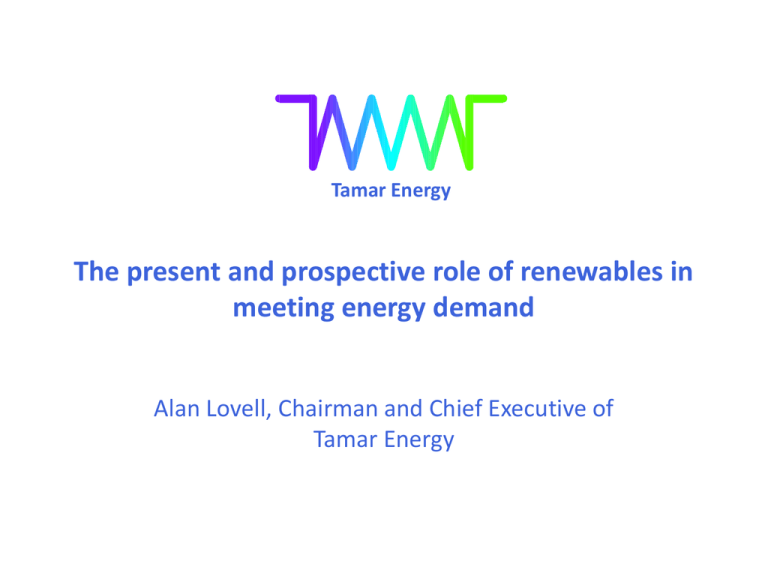
Tamar Energy The present and prospective role of renewables in meeting energy demand Alan Lovell, Chairman and Chief Executive of Tamar Energy Renewables tick a lot of boxes….. Do help to ‘plug the gap’ Fulfil Britain’s commitments to the EU Are in most cases genuinely sustainable Assist security of supply Provide employment and some export opportunities Can have other benefits such as dealing with waste …….. but are expensive, especially those which are intermittent and unpredictable There is a 54 GW electricity generation gap projected by 2020 Overall energy demand will exceed supply UK generating capacity vs demand in 2020 (GW) 160 140 120 100 80 60 40 20 0 Existing (post decommission) Planned or in construction The Gap 3% 2% 7% Sources: DECC ‘Renewables Roadmap’ July 2011, DECC energy trends June 2011, DECC ‘UK Low Carbon Transition Plan’ 2009, Demand 41 % 3 The EU Energy Package sets ambitious targets Highlights of the “20 / 20 / 20” targets embedded in the EU Energy Package Mandatory target of 20% emissions reduction below 1990 levels by 2020 Mandatory target of 20% of primary energy consumption to come from renewables by 2020 - Burden sharing among Member States – UK given a 15% target - Includes transport and heating as well as electricity Efficiency target for primary energy consumption of 20% by 2020 The UK is way behind most of its European neighbours EU Energy Package 2020 renewable energy target 2005 actual % of renewable power in generation mix 2020 target Renewable energy consumption has increased markedly over the last six years Source: Renewable Energy roadmap, Energy trends Where does our Renewable Electricity come from now? 2010 2011 Source: Energy trends, March 2012 … and research indicates that the 15% target can be achieved Source: Analysis of Renewables Growth to 2020, AEA Technology Technology breakdown of delivery of 15% target in 2020 Source: Energy trends, March 2012 Renewable energy is not cheap Even by 2020 the projected levelised cost for most technologies will be more than CCGT To achieve the growth to date has required generous subsidies. e.g. Solar PV feed-in-tariff at £430/MWh Offshore wind: - 2 ROCs at £50 = £100/MWh - Power price of £60/MWh and that conceals the cost of the back-up ACL credentials for talking on this subject 2006 – 2009 Chief Executive, Infinis Landfill gas & early onshore wind developments 2009 – 2011 Non-exec Director, Low Carbon Solar Large scale solar Current portfolio Chairman & Chief Executive, Tamar Chairman, TidalStream Non-exec Director, Progressive Energy Anaerobic digestion Large platform for tidal turbines Carbon capture & storage project Anaerobic digestion will never be huge but it gets a lot right It is a waste solution, delivers renewable energy and produces a high quality fertilizer It delivers baseload power The output can be electricity, gas to the gas grid or transport fuel The costs are reasonable, estimated at just over £100/MWh Tamar’s plan: To build a network of 44 AD plants to generate 100MW More than £65m equity capital raised to build AD plants in the UK Exceptional consortium of institutional and strategic investors RIT and Lord Rothschild, Fajr Capital, Duchy of Cornwall and Sainsbury’s Management team with track record across all areas Pipeline of developed projects, many with planning permission Larger (≥2MW) food waste plants We will use a strong balance sheet to grow the market rapidly, and will reinforce long-term feedstock security through regional focus Investor return will come from building on the balance sheet a portfolio of plants with stable cashflows Tidal: The UK has half of Europe’s potential tidal energy Turbine development is just reaching maturity and attention is turning (belatedly) to deployment Key is to deliver lots of power from just one foundation The big prize is the Pentland Firth TidalStream is developing a 60 metre high platform which has many advantages: - Can access the deep fast-flowing water - Up to 10MW on one foundation - Economical to take to site and for maintenance TidalStream Cost Model (hard colour bars audited by B&V) Capture Capture and Storage (CCS) Carbon Capture and Storage (CCS) captures up to 90% of the CO2 emissions produced from fossil fuels used in electricity generation and industrial processes, preventing the CO2 from entering the atmosphere. Furthermore, the use of CCS with renewable biomass is one of the few carbon abatement technologies that is 'carbon-negative' - actually taking CO2 out of the atmosphere. The CCS chain consists of three parts: Capture: Separation of CO2 from gases produced in electricity generation and industrial processes by one of three methods: pre-combustion capture, post-combustion capture & oxyfuel combustion. Transport: CO2 is then transported by pipeline or potentially by ship Storage: CO2 is then stored in carefully selected geological rock formation that are typically located several kilometres below the earth's surface, and usually offshore. CCS Deployment Courtesy of the Carbon Capture and Storage Association. Presentation given at the launch of 'A Strategy for CCS in the UK and Beyond‘ 8 September 2011 Globally, carbon capture and storage is vital Three elements to a project: Benefits: • Electricity from fossil fuels without dangerous emissions • • • Use UK coal/gas safely Achieve climate targets Global opportunities • Help to other industrial emitters: steel works, ammonia plant, aluminium plant, etc • Keep industrial companies in business Jobs in key parts of country Storage under North Sea or Enhanced Oil Recovery • • • • Potential oil revenues to Treasury Use of own oil helps security of supply Potentially this is the one low carbon sector that can contribute positively to the Treasury Concluding remarks Incentives have driven big growth in renewable generation - possible we can hit EU 2020 targets Focus is now switching (correctly) to more economic technologies - ending of high solar FiT - Government statements about offshore wind Encouragement for cheaper, baseload technologies and those that deal with waste CCS is potentially the big win Contact Details Tamar Energy 52 Jermyn Street London SW1Y 6LX Tel. 020-7255-7500 info@tamar-energy.com www.tamar-energy.com
